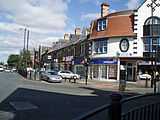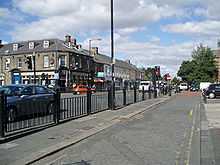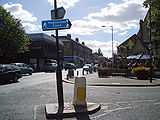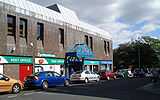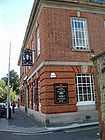Gosforth
| Gosforth | |
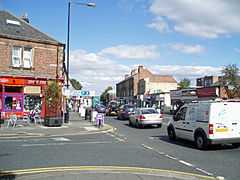 Gosforth High Street |
|
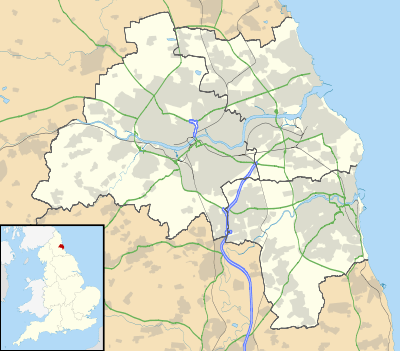 Gosforth |
|
| Population | 23,620 (2001 Census) |
|---|---|
| OS grid reference | NZ250699 |
| Metropolitan borough | Newcastle upon Tyne |
| Metropolitan county | Tyne and Wear |
| Region | North East |
| Country | England |
| Sovereign state | United Kingdom |
| Post town | NEWCASTLE UPON TYNE |
| Postcode district | NE3 |
| Dialling code | 0191 |
| Police | Northumbria |
| Fire | Tyne and Wear |
| Ambulance | North East |
| EU Parliament | North East England |
|
|
Coordinates: 55°00′25″N 1°37′23″W / 55.007°N 1.623°W
Gosforth is an area of Newcastle upon Tyne, England, situated to the north of the city centre. Gosforth constituted an urban district from 1895 to 1974, when it became part of the City of Newcastle upon Tyne. It has a population of 23,620.[1]
There are two electoral wards that bear the Gosforth name, East Gosforth and West Gosforth, and modern-day Gosforth includes other wards such as Parklands.
History
The origin of the area's name is thought to have come from the title Gese Ford, meaning "the ford over the Ouse", referring to a crossing over the local River Ouse or Ouseburn, but others think that it comes from the Old English Gosaford, meaning "a ford where the geese dwell", and it is first recorded as Goseford in 1166.[2] Richard Welford notes that the names of North and South Gosforth come from the north and south of the River Ouse.[3] Gosforth is first mentioned in 1166, and thus some think the settlement developed at this time[4] and South Gosforth dates back past 1319, when it has been noted that the English Army retreated there from a siege on Berwick.[5] According to the 19th-century publication, A Topographical Dictionary of England, the township of Gosforth was held of the crown by the Surtees family from 1100 to 1509, when it passed by marriage to Robert Brandling.[6]
Parishes and urban districts
In 1777, Gosforth contained 7 townships of North Gosforth, South Gosforth, Coxlodge, Kenton, Fawdon, East Brunton, and West Brunton.[3] By order of the Local Government Board on 20 September 1872, the parishes of South Gosforth and Coxlodge were constituted into a district, governed by the South Gosforth Local Board. After the 1894 Local Government Act, it became the South Gosforth Urban District Council. A year later, by a Northumberland County Council order dated 14 March 1895, the title was changed again to Gosforth Urban District Council.[7]
On 15 July 1903, the District Council applied for an order from Northumberland County Council, to extend its boundaries to include the parishes of North Gosforth, East Brunton, West Brunton, Fawdon and the greater part of Kenton. On 9 September 1903, an inquiry was held into the Gosforth Scheme, but the proposal was refused. The parishes of Coxlodge and South Gosforth were amalgamated into the parish of Gosforth in 1908. Gosforth then extended its boundaries after the County of Northumberland Review Order 1935, to include part of Castle Ward Rural District. This comprised parts of East Brunton, Fawdon, and North Gosforth civil parishes. The Gosforth Urban District Council was finally abolished on 1 April 1974 to become part of the City of Newcastle Metropolitan Borough Council.[7]
St. Nicholas' Church
The parish church, St. Nicholas's Church was built in 1799, to the design of John Dodds, replacing an earlier church building. The architect John Dobson was responsible for some alterations to the church in 1818–20. The eastern half was added in 1913, to the designs of Hicks and Charlewood. A new vestry was added in 1959, partly as a war memorial, designed by F.W. Harvey. The church's predecessor was mentioned in 1170, when the advowson changed hands. In 1220, Gosforth was also mentioned Brand's History of Newcastle. The earliest parish register is dated 1697.[8]
Mining
In the 19th century, Gosforth was the location of a number of collieries, including Gosforth[9] and Coxlodge Collieries.[10] Gosforth Colliery was located in South Gosforth, while Coxlodge Colliery was west of the Great North Road. Coxlodge Colliery comprised two pits; the Regent pit, where the Regent Centre now stands, and the Jubilee pit further west on Jubilee Road.
Bulman Village
The modern-day centre of Gosforth, straddling the Great North Road (here called Gosforth High Street), originated in 1826 as a settlement known for several decades as Bulman Village. It originally consisted of a number of properties large enough to qualify occupiers for the franchise (so-called 'forty shilling freeholders'), built by the Bulman family in an attempt to provide voters for their cause in the 1826 elections. A stone bearing the name 'Bulman Village' survives and was incorporated in the façade of a later building, the Halifax Bank building north of the Brandling Arms public house.
The Blacksmith's Arms public house on Gosforth High Street, stands on the site of the original blacksmiths forge.
Population
At the 2001 census there were 23,620 people living in Gosforth. In the nineteenth century Gosforth's population was largely deemed by the coal trade. In 1801 there were 1,385 inhabitants, most of whom lived in Kenton, and were employed in the colliery there. In 1831 the population had risen to 3,546, partly due to the opening of the Fawdon and Coxlodge collieries. Between 1831 and 1871 the population only grew by a very small amount to 3,723, due to the pits at Fawdon and Kenton having ceased to function.[3]
Archaeological finds
There have been a number of archaeological finds in Gosforth,[11] with the earliest piece being a prehistoric flint flake that was found in 1959.[12] In 1863 a 2nd-century Greek Colonial coin was found in a garden in Bulman Village.[13] A Roman altar was found in North Gosforth.[14]
Landmarks
It has a large business complex called the Regent Centre, which houses organisations including HM Revenue & Customs. Gosforth's main High School is Gosforth Academy, and some of the private schools in Gosforth are Westfield School and Newcastle School for Boys. St Nicholas Hospital is also located in Gosforth, which houses the Jubilee Theatre, a Victorian Theatre built in 1899.[15]
Areas of Gosforth
Apart from South Gosforth, many residential districts of Gosforth are suffixed "Park". There is Bridge Park, Brunton Park, Gosforth Park (including Newcastle Racecourse), Grange Park, Greystoke Park, Grove Park, Melton Park, Newcastle Great Park and Whitebridge Park. East of the Great North Road, Garden Village was developed on 'garden suburb' lines in the 1920s to house workers at the nearby LNER electric train depot (now the Metro depot).
Areas of Gosforth have been used as a filming locations for television shows and films. Gosforth Park was used as a location in Get Carter[16] and Whitebridge Park which was used in an episode of Wire in the Blood. Melton Park has the ruins of a chapel which dates back to early medieval or late Norman times. It may have been built on the site of a Roman fort.[17]
Brunton Park is a neighbouring estate to the Newcastle Great Park. The oldest parts in the estate have existed since the early 1930s. The rest of the estate was built during the 1940s and 1950s. It contains a number of local convenience shops. One of the newest expansions of Newcastle is the Great Park to the north of Gosforth.
Sports and entertainment

Gosforth has sports facilities such as Gosforth Swimming Pool among others. Famous sportsmen from Gosforth include footballer Alan Shearer and athlete Jonathan Edwards. The swimming pool was given a slight revamp during early 2011.[18] Newcastle's Horse Racecourse is based in Gosforth Park.
Gosforth has had a long connection with local rugby football, currently being home to the Northern Rugby Club (founded 1875)[19] and namesake of the nearby current incarnation of the Gosforth Rugby Club (originally formed in 1877). The city's rugby club, the Newcastle Falcons, was also originally based in Gosforth, also originally being called Gosforth Rugby Club, and later Newcastle Gosforth.[20] Gosforth Central Park has two bowling greens with a women's and a men's club, two tennis courts, a basketball court and a fenced play area.[21]
Gosforth has a number of golf courses including the City of Newcastle Golf Club, High Gosforth Golf Course and Gosforth Golf Course, which is a 90-acre (360,000 m2) golf course that opened in 1906.[22] Gosforth has been home to the South Northumberland Cricket Club since 1892,[23] which is home itself to the South North Bulls team.
Gosforth formerly had two cinemas, the Royalty Cinema on the High Street and the Globe Cinema on Salters Road. The Royalty Cinema opened on 17 October 1934 and closed on 30 December 1981.[24] A video documentary, Last Reel at the Royalty, viewable online was produced about the cinema's history. The Globe Cinema later became a bingo hall and is now Poon's Gosforth Palace Chinese restaurant.
The ground on which the Asda supermarket stands was formerly the Gosforth Greyhound Stadium until the late 1980s and the home of Northumberland RFU. The stadium had also previously been a Speedway Track from 1929–30.[25][26]
The Opus Art Gallery is located just off the High Street.[27]
Business
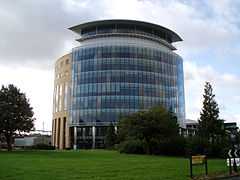
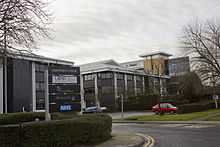
Many businesses have offices in the Regent Centre complex, near the High Street, as well as other business parks including Gosforth Industrial Estate, located near the Metro train sheds, and Gosforth Business Park, located between Gosforth Park and nearby Longbenton.
Gosforth houses Northern Rock House, the headquarters of the savings and mortgages business of Virgin Money, formerly the Northern Rock bank, which are next to the Regent Centre development on Regent Farm Road. In September 2008 Northern Rock was nationalised due to the problems it has experienced during the credit crunch and later in January 2012 it was bought by Sir Richard Branson's Virgin Money. Virgin has promised that no compulsory redundancies are to be made to any current Northern Rock employees and has vowed to keep the headquarters to the new savings and mortgages business in the former Northern Rock buildings.
Northern Rock had a landmark tower building, built in the 1960s, which in the 2000s was replaced with a 10 storey office building; Partnership House, as it is now known since being sold by the bank, houses the Real Partnership, a coalition between Newcastle City Council and Carillion (formerly Eaga). Other resident companies of Regent Centre include the National Health Service (NHS) and the Department for Transport among others.
Greggs, the largest national retail bakery, originally started with John Gregg's single shop on Gosforth High Street in 1951; initially Greggs was known as Greggs of Gosforth.[28] In 1968 Greggs opened their first large-scale bakery on the Gosforth Industrial Estate, but in 2011 moved to a £16.5 million site in Gosforth Business Park on Gosforth Park Way.[29] In 2012 the Greggs on the High Street was given a concept makeover depicting their 'Greggs the Bakery' format.[30]
Procter & Gamble PLC formerly had their UK head office in Newcastle, at Hedley House, Gosforth, that was developed in the 1950s. The principal building in this complex, Hedley House itself (c.1953) was designed by Sidney Burn, staff architect to Thos. Hedley & Co., soap manufacturers, in association with consultant architect Anthony Chitty. In 1963/4 an addition to the site included a computer block by Sir Basil Spence (1963/4). The landscape setting was designed by B. Hackett. The 1994 extension to the site (now demolished) won the 1994 New Building Category in the Lord Mayor’s Design Awards. Procter & Gamble left the site in 2001 to move to Cobalt Business park, near the Eastern City Boundary with North Tyneside, and the Gosforth land is now used for residential properties.[31]
The Sage Group have their headquarters in North Park which is just north of Gosforth and in the Great Park developments; another office building occupied by the NHS is also located near the Great North Park. In 2004 Sage moved its headquarters to this location from a site in Benton.
Shopping
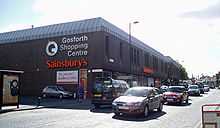
Gosforth High Street has been home to local shops for over a hundred years.[32] Shops on the High Street include a branch of Boots, Thorpes (a well established local hardware store), estate agents, hairdressers and banks, among many others. In 1979 the Gosforth Shopping Centre opened on the High Street and connects to Gosforth Central Park; shops here include a Sainsbury's and a WHSmith. There is also a branch of Virgin Money and a Cancer Research charity shop. The park was created on the site of a former nursery for £10,000 and opened on 6 August 1932.[33] A theatre stood on part of the site of the Gosforth Shopping Centre. The stage faced the park and a huge door could be opened to entertain an outdoor audience. The theatre was damaged in a fire shortly before the Shopping Centre was built.
Many shops have come and gone from Gosforth High Street over the years, including familiar names such as: Robinson's Pet Shop which was near Elmfield Road; Boydell's Toys on the corner of Hawthorn Road; Maynard's sweet shop, the Toddle Inn cafe and Laidlaw's hardware and decorating store – all of which were situated opposite the junction with Saint Nicholas Avenue; and Moods – a stationery and gift shop – which stood where the Gosforth Centre is now, opposite Ivy Road.
The High Street had a Woolworths store,[34] which closed on 3 January 2009, due to the company being in administration. On 10 December the former Woolworths store reopened as a Co-operative Food store,[35] after plans to change the store into an Italian restaurant were rejected.
The car park on the corner of the High Street and Salters Road is the former site of a school.[31]
As of spring 2009 local councillors, Trinity Church and Gavin Black (agent for Gosforth Shopping Centre) are working on a strategy for developing Gosforth High Street. Gavin Black are wishing to use a covered entrance near Trinity, bring the entrance of the shopping centre forward. This is hoped to tie in with the Trinity Square development, on the area of land in front of the church. Trinity Square is to be the focal point of the High Street, giving a space for farmers' markets, street theatre and other community activities. There may be a raised paved link across to the shopping centre. This project may cost around £400,000, meaning this may be a long term plan. There was to be a mall refurbishment costing £600,000 in 2010. As of late 2009 units 22 and 23 are currently under discussion for a possible restaurant site. Nick Cott, Councillor for West Gosforth ward, noted that current discussions were about transport issues and environmental improvements.
Gosforth Shopping Centre is owned by Graham Wylie, co-founder of the Sage Group, which itself is headquartered just outside of Gosforth in the North Park development.[36]
Supermarkets
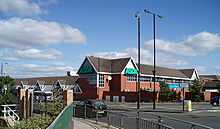
Opposite Regent Centre interchange is a 24-hour Asda, which lies on the site of a former dog-racing track. The Asda supermarket was refurbished and extended[37] in 2007 to include a photographic service centre and restaurant. It was extended again in 2014 to include a new petrol station.
Gosforth is also host to many smaller-type supermarkets, designed for quick "Essentials" service, such as the Cooperative Food store in the Regent Farm estate, there is also a smaller Asda store (former Netto), which was built on the ground of a former Kwik Save store. A Marks & Spencer Food store opened in late 2014 which stands on the site of the Multi York furniture shop opposite the Regent Centre Interchange.[38]
In 2008, Sainsbury's opened a store in Gosforth High Street's Gosforth Shopping Centre, on the site of a former Kwik Save/Somerfield store. Nearby Kingston Park houses one of the country's largest Tesco supermarkets, which is known as a "Tesco Extra" superstore.[39]
Newcastle City Council reported to Great Park residents in a meeting that it has outline planning permission in 2007/08 for a new supermarket. However no such location has yet been confirmed.
Coffee shops and public houses
In addition to local cafés such as Trinity Cafe, Rosies and Great Coffee, the high street also has chain cafés including a Caffè Nero and a Costa Coffee.
The Brandling Arms pub on the High Street has its own local edition of My Monopoly, using Gosforth locations. Other pubs on Gosforth High Street are the Gosforth Hotel, the Queen Victoria (known for a short time as Northern Lights), the Blacksmith's Arms, Barca (formally Earl Grey) and the Job Bulman, a branch of Wetherspoons located in the former 1920s post office building on St Nicholas Avenue, and named after the founder of Bulman Village. The County Hotel, towards the southern end of the centre of Gosforth, is the southernmost High Street pub famed for its large selection of real ale. Former public houses in Gosforth include the Collingwood in Regent Farm, and the Royal George in Brunton Park which closed in June 2009. The Three Mile Inn, which includes Scalini's (an Italian restaurant), is located north of the High Street on the historic Great North Road.
South Gosforth has three pubs: The Millstone on Haddricksmill Road; the Brandling Villa at the corner of Haddricksmill Road and Station Road; and The Victory on Killingworth Road.
Transport, communication and amenities
Transport
Gosforth is served by five Tyne and Wear Metro stations: Ilford Road, South Gosforth, Regent Centre, Wansbeck Road and Fawdon. The control centre for the Metro system is located at South Gosforth station, and the main depot and car sheds are nearby. Regent Centre's Transport Interchange also contains a large bus station and multi-storey car park.
In 1902 Gosforth was linked by tramway to Wallsend, then Newcastle a year later; this tramway has long since been removed as other travel links evolved.[32] The Gosforth Park Light Railway extended the tramlines from the High Street to the gates of Gosforth Park; this service ceased in 1930.[40] In the late 1850s, prior to horse trams, a resident by the name of Mark Frater established an omnibus service connecting Gosforth and Newcastle.[8]
In 1864 Gosforth was connected to the Blyth and Tyne railway.[41] In 1905 the Ponteland Railway was opened from Gosforth to Ponteland. Three stations in Gosforth were on this route, South Gosforth (the 1864 station renamed), West Gosforth and Coxlodge.[42] With the opening of the Metro system in the 1980s the locations of these stations were used for the modern South Gosforth, Regent Centre and Fawdon stations respectively.
In 2009 Newcastle City Council agreed to £9.6 million worth of plans to revamp roads around Gosforth, including the High Street and the Great North Road. With the proposed improvements there would be up to 13 months of roadworks, starting in 2012. The High Street is to have bus lanes, and other traffic is to be confined to one lane in each direction. The city council aims to get 90% of the funding for the congestion improvements from the Department for Transport.[43]
Communications
NE3 is the postcode area for Gosforth and BT Landlines start with (0191) 213, 217, 223, 226, 236, 255, 279, 284, and 285.
Cable, provided by Virgin Media, does not fully cover Gosforth. For example it is not available to homes covered by the Wideopen Telephone Exchange in the north of the suburb, or in Garden Village to the east of the Asda superstore, or the Regent Farm area. ADSL and ADSL2+ are widely available in Gosforth, and BT Infinity broadband was activated in 2011. Gosforth will be a pilot area for the G.fast DSL technology.[44]
Amenities
In the late 19th century a volunteer fire brigade was started in Gosforth,[8] later in 1894 a fire station was built on Gosforth High Street and since 1990 Gosforth has been served by Gosforth Community Fire Station, located on Jubilee Road.[45] Gosforth's first police station opened in 1857, with 4 policemen, due to the County Constabulary Act of 1856.[3] Its last police station, on Hawthorn Road,[46] closed in the 1990s and Gosforth is now served from Etal Lane police station.
Gosforth has a number of post offices, however on 1 July 2008 the Post Office announced the next set of post offices which would close; the Gosforth Garden Village branch and a nearby branch in Kenton closed.[47] A public meeting was held about the closure the Garden Village post office on the evening of 28 July. Postal facilities had first been introduced in Gosforth in around 1840.[3]
Whilst the Fire brigade was stationed in Gosforth there was a siren that used to alert motorists and public alike that they would be leaving the hidden entrance. The alert was the original All Clear Siren from Second World War.
An unattended mortuary was situated in what was at one time quite an isolated rural spot to the east of the Three Mile Bridge. This small single-storey red-brick building with green doors was surrounded by trees and a crooked metal fence and was used for people who had died from infectious diseases or had been killed in road traffic accidents. Residents of nearby Burnside Road (built in the late 1950s) would hear ambulances pass down the lane in the middle of the night and see undertakers arrive to collect bodies during the day. This continued into the 1960s. When a housing estate was built in the 1980s, the site of the mortuary wasn't built on and is currently a small car parking area.[48]
Gosforth Library
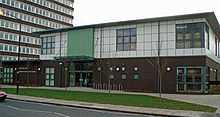
Gosforth has a public library which was re-built in 2007. In November 2006, the old Gosforth Library was closed and moved to a nearby temporary location. The single-storey building was subsequently demolished and has been replaced by a new two-storey building. The new Library and Customer Service Centre, costing £2.8 million opened on 17 December 2007. The Library was officially opened on 8 February 2008 by John Grundy, a local television presenter; music students from the then Gosforth High School also performed at the opening.[49]
The Gosforth Customer Service Centre at the library includes a PayPoint, and the library has a self-service facility.[50] The new building will also incorporate 'public art' to give the Centre an identity and a connection with the local area. The Library is also used as a Polling Station.[51]
Gosforth Civic Hall
The current Civic Hall in Gosforth is on Regent Farm Road and was built in the 1970s as a replacement for the old Central Hall on the High Street. A Second World War plaque is located in the Hall. As of 2011 the hall is not regularly used and the council are looking at other potential community uses for the building.
Education
Primary schools
First schools |
Gosforth Academy in 2007 Middle schools
High schools
Independent schools
Sixth form colleges
Adult education
|
Notable people
Born in Gosforth
- Donna Air – actress and television presenter.[52]
- Michael Chopra – footballer for Blackpool F.C.[53]
- Robbie Elliott – retired footballer, current strength coach for United States U-20 men's football team.[54]
- Anna Gilthorpe – actress.[55]
- Wilfred Josephs – composer.[56]
- Ben Price – actor.[57]
- Alan Shearer – retired international footballer.[58]
Residents of Gosforth
- Richard Adams – fair-trade businessman – lived in Gosforth.[59]
- Jonathan Edwards – triple jump world record holder.[60]
- John Grundy – television presenter, teacher and author.
- Tony Harrison – poet.
- Rowland Hodge – shipbuilder (lived at Coxlodge Hall).[61]
- David Knopfler – guitarist in Dire Straits, moved to Gosforth as a child, brother of Mark.
- Mark Knopfler – guitarist and vocalist in Dire Straits, moved to Gosforth as a child.[56]
- Andrew Leslie – shipbuilder (lived at Coxlodge Hall).[4]
- Sally Morton – Tyne Tees Television announcer.[62]
- Neil Tennant – musician, and one half of the Pet Shop Boys. The Tennants moved from North Shields to Gosforth when Neil was young.[63]
- Nolberto Solano – Former Newcastle United footballer.
- Olga and Betty Turnbull, child entertainers of the 1930s who performed for Royalty.
Listed buildings
There are a number of buildings with listed status in Gosforth:[31]
- The Stables, The Drive (Grade II)
- The Lodge, 2 The Drive (Grade II)
- Burnstead, Broadway East (Grade ll)
- All Saints Church, West Avenue (Grade II)
- West Avenue Methodist Church (now Trinity Church) (Grade II)
- The County Inn, High Street (Grade II)
- 1–2 Roseworth Terrace (Grade II)
- 32–36 and 38–52 High Street (Grade II)
- 7–21 and 23–33 The Grove (Grade II)
- 39–73 Graham Park Road flats (Grade II)
- The Queen Victoria, High Street (Grade ll)
- The Gosforth Hotel, High Street (Grade ll)
- 31–49 Moor End, Moor Cresent (Grade ll)
- Yard House, Roseworth Cresent (Grade ll)
Nearest places |
Nearest metro stations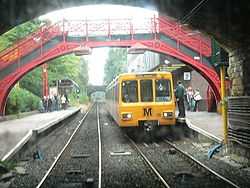 South Gosforth Metro station, and its 1864 bridge |
Photo gallery
| Gosforth High Street | ||||||||||||
|---|---|---|---|---|---|---|---|---|---|---|---|---|
|
References
- ↑ "Census 2001 : Urban Areas : Table KS01 : Usual Resident Population". Office for National Statistics. Retrieved 2009-08-26.
- ↑ Stan Beckensall (2004). Northumberland Place-Names. Butler Publishing, Thropton, Morpeth, Northumberland, NE65 7LP. ISBN 0-946928-41-X.
- ↑ 3.0 3.1 3.2 3.3 3.4 Welford, Richard (c. 1879). A History of the Parish of Gosforth, In the County of Northumberland. Walter D. Welford, Newcastle upon Tyne.
- ↑ 4.0 4.1 "Newcastle upon Tyne". northumbrian-coast.co.uk. Retrieved 2008-05-04.
- ↑ Whellan, William (1855). History, Topography, and Directory of Northumberland. Whellan and Co. p. 454. Retrieved 2008-05-04.
The village of South Gosforth is situated two and a half miles north-east by north of Newcastle. Here it was that the English army retreated when on its way to the siege of Berwick, in 1319.
- ↑ Lewis, Samuel. A Topographical Dictionary of England. Retrieved 2008-09-30.
- ↑ 7.0 7.1 "Reference number UD.GO". Tyne & Wear Archive Service.
- ↑ 8.0 8.1 8.2 Harbottle, George. Gosforth and Its Parish Church: A Thousand Years of History. ISBN 0-907113-00-1.
- ↑ "Gosforth Colliery". The Durham Mining Museum. Retrieved 2008-05-04.
- ↑ "Coxlodge Colliery". The Durham Mining Museum. Retrieved 2008-05-04.
- ↑ "Local Histories G – Gosforth". Site Lines. Retrieved 2010-03-14.
- ↑ "Tyne and Wear HER(1343): Gosforth, flint flake – Details". Site Lines. Retrieved 2010-03-14.
- ↑ "Tyne and Wear HER(1349): Gosforth, Roman coin – Details". Site Lines. Retrieved 2010-03-14.
- ↑ "Tyne and Wear HER(169): North Gosforth, Roman altar from the Chapel – Details". Site Lines. Retrieved 2010-03-14.
- ↑ "Theatre". Juniper Productions. Retrieved 2008-04-05.
- ↑ "Get Carter". Movie Locations. Retrieved 2010-03-13.
- ↑ "Hidden Chapel in Gosforth estate". BBC News. 2006-05-19. Retrieved 2008-04-05.
- ↑ "Gosforth Pool's £80k revamp is hailed by users". Evening Chronicle. 2011-08-05. Retrieved 2011-08-29.
- ↑ "History". Northern Rugby Club. Retrieved 2008-07-28.
- ↑ "Club History". Gosforth Rugby Club. Retrieved 2008-07-28.
- ↑ "Gosforth Central Park". Newcastle City Council. Retrieved 2008-07-28.
- ↑ "Gosforth Golf Club". Gosforth Golf Club. Retrieved 2008-07-26.
- ↑ "South North Bulls". South Northumberland Cricket Club. Retrieved 2008-07-26.
- ↑ "Royalty Cinema". Royalty Cinema. Retrieved 2008-07-26.
- ↑ "Gosforth (Newcastle)". Defunct Speedway. Retrieved 2008-04-06.
- ↑ "Stadiums that came and went". The Journal. 2010-09-09. Retrieved 2010-09-25.
- ↑ "Opus". Opus Art Gallery. Retrieved 2010-03-13.
- ↑ "How Greggs Began". Greggs. Retrieved 2010-03-13.
- ↑ "Bakery giant Greggs opens doors on £16.5m site". The Journal. 2011-12-01. Retrieved 2012-01-07.
- ↑ "Philip Watts creates new Greggs concept". Design Week. 2012-07-10. Retrieved 2012-07-15.
- ↑ 31.0 31.1 31.2 "Gosforth Conservation Area Character Statement" (PDF). Newcastle City Council. Retrieved 2010-03-13.
- ↑ 32.0 32.1 "Gosforth High Street". TimArchive. 2000-11-25. Retrieved 2008-04-05.
- ↑ "Gosforth History". Gosforth Life. Retrieved 2008-05-04.
- ↑ "Woolworths Stores to close". News Guardian. 2009-01-05. Retrieved 2010-03-13.
- ↑ "Whitley Bay Woolworths store taken over". The Evening Chronicle. 2009-11-23. Retrieved 2010-03-13.
- ↑ "Sage founder's next success looks like a racing certainty". The Northern Echo. 2005-07-05. Retrieved 2011-02-17.
- ↑ Submission of details of extraction, sound insulation and odour extraction to comply with conditions 5, 6 and 7 of permission 2007/0124/01/DET dated 28.02.07 Erection of single storey extension to south elevation to provide restaurant and retail area and alterations to car park layout, Newcastle City Council
- ↑ "Marks & Spencer Simply Food Store". Worthingtons. 2014. Retrieved 2 December 2014.
- ↑ Dangerfield, Andrew (16 January 2007). "The continued rise of Tesco non-food". BBC News. Retrieved 27 January 2007.
Staff roller blade in the UK's largest Tesco in Newcastle.
- ↑ "Tyne and Wear HER(4626): Gosforth Park, Tramway/Light Railway – Details". Site Line. Retrieved 2010-03-14.
- ↑ "South Gosforth station". Northumbrian Railways. Retrieved 2010-03-13.
- ↑ "Ponteland and Darras Hall branch". Northumbrian Railways. Retrieved 2010-03-13.
- ↑ "Gosforth road revamp could leave Newcastle in a jam". The Eventing Chronicle. 2009-10-30. Retrieved 2009-11-08.
- ↑ "BT CEO sets out ultrafast broadband vision". BT plc. 30 January 2015. Retrieved 30 January 2015.
- ↑ "Gosforth Community Fire Station". Tyne and Wear Fire and Rescue Service. Retrieved 2008-11-27.
- ↑ "Development Control Committee – Post Implementation Review" (PDF). Newcastle City Council. Retrieved 2010-03-13.
- ↑ "Post Office consultation". BBC Tyne News. 2008-07-01. Retrieved 2008-10-12.
- ↑ "Site of former mortuary near the Three Mile Bridge – Google Maps". Retrieved 2011-01-22.
- ↑ "John Grundy to open Gosforth Customer Service Centre and Library". Newcastle City Council. 2008-02-04. Retrieved 2010-03-13.
- ↑ "Gosforth Customer Service Centre and Library". Newcastle City Council. Retrieved 2008-04-02.
- ↑ United Kingdom local elections, 2009 – West Gosforth
- ↑ "Stars happy on home ground". icNewcsatle. 2001-12-20. Retrieved 2008-04-11.
- ↑ "Chopra keeping head down ahead of derby". The Northern Echo. 2008-04-11. Retrieved 2008-04-11.
- ↑ "Footballer's wife is living the dream". The Journal. 2003-03-31. Retrieved 2008-04-11.
- ↑ "Teen dream gives Anna a starring role". The Journal. 2010-03-09. Retrieved 2010-03-13.
- ↑ 56.0 56.1 "Famous people with North East Connections" (PDF). Newcastle City Council. September 2004. Archived from the original on 2008-05-28. Retrieved 2008-04-11.
- ↑ "Going for gold at the Great North Run". Cafod. 2006-10-02. Retrieved 2008-04-11.
- ↑ "Newcastle and Blackburn legend Alan Shearer – simply the best". SportIngo. 2008-03-13. Retrieved 2008-04-11.
- ↑ "Honours for 'inspirational achievement'". Newcastle University. 2005-05-06. Retrieved 2009-10-06.
- ↑ Knight, Tom (2007-02-12). "Olympian Jonathan Edwards has 'crisis of faith'". London: The Telegraph. Retrieved 2008-04-11.
- ↑ "Jodie Kidd – How We Did It – Who Do You Think You Are". BBC. Retrieved 2010-03-13.
- ↑ "50 years of entertainment". The Evening Chronicle. 2009-01-17. Retrieved 2009-01-17.
- ↑ "Pet Shop Boys singer mourns loss of father". The Journal. 2009-01-22. Retrieved 2009-01-22.
External links
| Wikimedia Commons has media related to Gosforth. |
- Ward Info: East Gosforth at Newcastle City Council
- Ward Info: West Gosforth at Newcastle City Council
- Gosforth Life – Photographs from Gosforth, Newcastle upon Tyne
- "Gosforth". GENUKI. Retrieved 2008-11-27.
- Kay's Geography: Gosforth page
| ||||||||||||||||||
